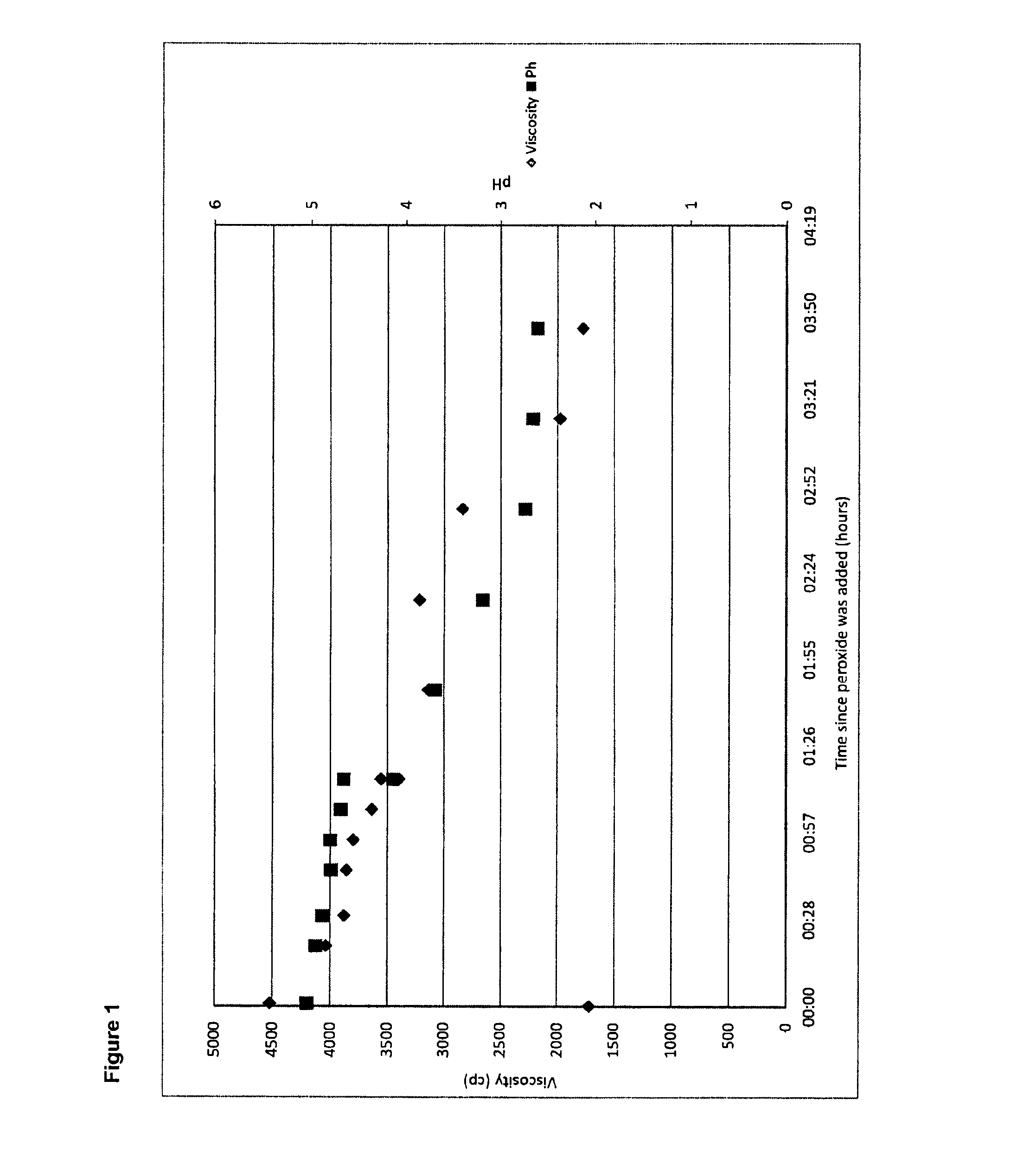Cellulose particulate material
- Summary
- Abstract
- Description
- Claims
- Application Information
AI Technical Summary
Benefits of technology
Problems solved by technology
Method used
Image
Examples
example 1
Method for Measuring Viscosity and pH with Reaction Time for Hydrogen Peroxide Treated Root Vegetable Pulp
[0121]Fresh carrots were peeled, chopped and cooked at 90° C. for 2 hours. The carrots were then homogenised in the cooking liquid, using a Silverson FX homogeniser, to form a pulp with particles less than 500 microns in diameter. The concentration of the pulp was measured, using a moisture analyser, to be 5% solids in water. The batch was then divided into a number of 1 litre samples each contained in a polypropylene bottle with tight fitting lid. These bottles were then placed in to a water bath of hot water regulated to 90° C. The internal temperatures of the bottles were checked periodically. When the temperature reached 90° C., 35% hydrogen peroxide was added to each bottle in a ratio of 1 part 35% peroxide to 1 part carrot solids. The bottles were then left in the water at 90° C. for varying lengths of time. Bottles were taken out of the water bath at intervals and cooled ...
example 2
Preparation of Low Viscosity Cellulose Particulate Material from Sugar Beet
[0122]900 g of sugar beet pellets were washed and hydrated by adding them to warm water, with dirty water being drained through a sieve. This sugar beet hydrate is placed in a large bucket in excess water and agitated before being scooped out with a colander and washed with water, to ensure that no stones / grit enter the next stage of processing
[0123]The washed sugar beet is then cooked for 3 hours at 100° C., before being homogenised using a Silverson FX homogeniser fitted with initially coarse stator screens and moving down to the small holed emulsifier screen (15 min process time for each screen). The solids are measured using an Oxford solids meter and the mixture adjusted to 2% solids by addition of clean water.
[0124]The mix is then placed in a 25 litre glass reaction vessel and the dry solids content in the vessel is calculated. Peroxide based on ratio of aqueous peroxide solution (at 35%) to the dry sol...
example 3
Comparative Study: Carrots
(A) Process Resulting in High Viscosity Material
[0128]Fresh carrots were cooked and homogenised to produce a pulp in water with 5% of carrot pulp solids. Hydrogen peroxide was then added in the ratio of 1 part carrot solids to 0.35 parts of peroxide solids. This mixture formed the reaction liquid. The liquid was then heated to 90° C. and reaction allowed to progress for 1 hr at which point the pH had dropped from 5.2 to 4.75. The resulting liquid was rapidly cooled and washed and filtered at which point the viscosity of a 1% solids mix in water was 3800 cps @ 10 rpm (measured on the Brookfield Viscometer with RV spindle heads, at 20° C.).
(B) Process Resulting in Low Viscosity Material
[0129]Fresh carrots were cooked and homogenised to produce a pulp in water with 5% of carrot pulp solids. Hydrogen peroxide was then added in the ratio of 1 part carrot solids to 0.35 parts of peroxide solids. This mixture formed the reaction liquid. The liquid was then heated ...
PUM
| Property | Measurement | Unit |
|---|---|---|
| Temperature | aaaaa | aaaaa |
| Temperature | aaaaa | aaaaa |
| Temperature | aaaaa | aaaaa |
Abstract
Description
Claims
Application Information
 Login to View More
Login to View More - R&D
- Intellectual Property
- Life Sciences
- Materials
- Tech Scout
- Unparalleled Data Quality
- Higher Quality Content
- 60% Fewer Hallucinations
Browse by: Latest US Patents, China's latest patents, Technical Efficacy Thesaurus, Application Domain, Technology Topic, Popular Technical Reports.
© 2025 PatSnap. All rights reserved.Legal|Privacy policy|Modern Slavery Act Transparency Statement|Sitemap|About US| Contact US: help@patsnap.com

